Anne-François-Louis Janmot (1814-1892) stands as a unique and compelling figure in the landscape of 19th-century French art. Often positioned as a transitional artist, his work bridges the fervent emotionalism of Romanticism with the introspective, spiritual concerns of Symbolism. A painter and a poet, Janmot's deeply personal vision was profoundly shaped by his unwavering Catholic faith, his classical training, and a sensibility that resonated with the burgeoning mystical undercurrents of his era. While perhaps not as widely known in his lifetime as some of his contemporaries, his art, particularly his magnum opus, Le Poème de l’âme (The Poem of the Soul), has garnered increasing appreciation for its sincerity, technical finesse, and profound spiritual depth.
Early Life and Formative Influences in Lyon
Born in Lyon, France, on May 21, 1814, Louis Janmot, as he was commonly known, was immersed from his earliest years in an atmosphere of devout Catholicism. His parents were deeply religious, and this spiritual grounding would become the bedrock of his artistic and personal life. Lyon itself was a city with a rich artistic and religious heritage, known for its silk industry but also for a particular strain of mystical Catholicism that influenced many of its creative inhabitants.
The early years of Janmot's life were marked by profound personal losses that undoubtedly shaped his introspective nature and his preoccupation with themes of life, death, and the spiritual realm. His younger brother passed away in 1823, followed by his sister in 1829. These experiences of grief at a formative age likely intensified his religious convictions and his search for meaning beyond the material world. This period saw him become involved with the Society of Saint Vincent de Paul, a charitable organization founded by Frédéric Ozanam, with whom Janmot shared a close intellectual and spiritual kinship. This engagement reflected a desire to translate faith into active compassion, a theme that subtly permeates his artistic vision.
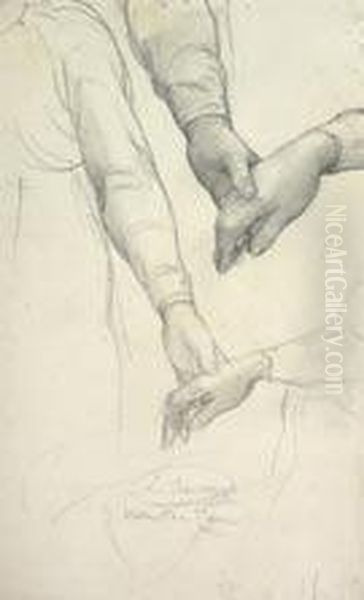
His education began at the Royal College of Lyon, where he excelled in his studies. It was here that his artistic inclinations began to surface, nurtured by the city's cultural environment. Lyon, at this time, was home to a distinct artistic school, often referred to as the Lyon School, which emphasized meticulous draughtsmanship, a certain spiritual gravity, and a preference for religious or historical subjects, often with a moral or didactic undertone. This local artistic climate provided the initial framework for Janmot's developing aesthetic.
Artistic Training: Lyon, Paris, and Rome
Janmot's formal artistic training commenced at the École des Beaux-Arts in Lyon, where he studied under masters such as Pierre Révoil and, significantly, Victor Orsel. Orsel, himself a product of the Lyon School and a painter deeply influenced by the German Nazarenes—artists like Johann Friedrich Overbeck and Peter von Cornelius who sought to revive Christian art through the purity of early Renaissance masters—imparted to Janmot a respect for clear composition, precise linearity, and spiritually imbued subject matter.
Seeking to broaden his horizons, Janmot moved to Paris in 1833. There, he entered the prestigious studio of Jean-Auguste-Dominique Ingres at the École des Beaux-Arts. Ingres, a towering figure of French Neoclassicism, was renowned for his exquisite draughtsmanship, his emphasis on line over color, and his admiration for Raphael. Under Ingres, Janmot further honed his technical skills, absorbing the master's dedication to formal purity and elegant contours. However, while Janmot deeply respected Ingres's teachings, his own artistic temperament leaned more towards a lyrical and spiritual expression that would eventually set him apart from strict Neoclassicism. Other students of Ingres, such as Théodore Chassériau, similarly blended Ingres's linearity with a more Romantic sensibility.
A pivotal experience in Janmot's development was his journey to Rome in 1835, accompanying his friend and fellow artist Claudius Lavergne, and Frédéric Ozanam. Italy, with its wealth of classical and Renaissance art, was a traditional pilgrimage for aspiring artists. Janmot was profoundly moved by the works of early Italian masters like Fra Angelico and Giotto, whose spiritual sincerity and clarity of expression resonated deeply with his own artistic and religious ideals. He also encountered the contemporary work of the Nazarenes in Rome, further reinforcing the direction Orsel had initiated. This period in Italy solidified his commitment to an art that was both technically refined and spiritually uplifting.
The Magnum Opus: Le Poème de l’âme (The Poem of the Soul)
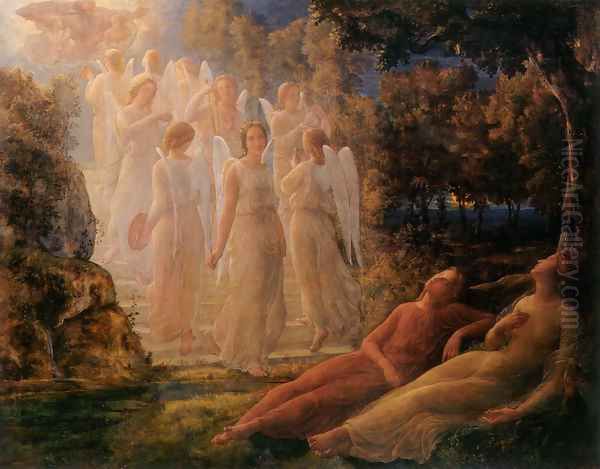
The most significant and defining work of Janmot's career is undoubtedly Le Poème de l’âme (The Poem of the Soul). This ambitious cycle, which occupied him for over four decades, from approximately 1835 to 1881, comprises a series of eighteen oil paintings and a further sixteen large-scale charcoal drawings, accompanied by a lengthy poem penned by Janmot himself. The entire ensemble narrates the allegorical journey of a soul, from its celestial birth through its earthly trials and tribulations, culminating in its spiritual ascent or, in some interpretations, its potential fall and redemption.
The first part of the cycle, consisting of the eighteen paintings, depicts the early life of the soul, personified as a young boy, and his female companion, representing the ideal or perhaps a twin soul. These early scenes are characterized by an ethereal beauty, a delicate palette, and a sense of innocent wonder. Works like The Golden Ladder (L'Échelle d'or), where angels guide the young souls, or The Ideal Flight (Le Vol idéal), showcase Janmot's lyrical style and his ability to convey profound spiritual concepts with a tender, almost naive charm. The influence of early Renaissance frescoes and the linear grace of Ingres are evident, yet imbued with a distinctly personal, mystical quality.
The second part, executed primarily in charcoal drawings, takes a darker, more dramatic turn, depicting the soul's confrontation with sin, temptation, and suffering in the earthly realm. The tone becomes more somber, reflecting the complexities and disillusionments of life. Titles such as Orgies (Les Orgies) and The Bad Path (Le Mauvais Sentier) indicate this shift. This duality in the cycle reflects a profound understanding of human existence, balancing a vision of divine origin and potential with the harsh realities of the fallen world.
Le Poème de l’âme was not met with widespread acclaim when parts of it were exhibited, notably at the Universal Exhibition of 1855 in Paris. The highly personal, almost esoteric nature of the work, combined with its departure from both the grandiloquence of official Academic art (as championed by figures like Jean-Léon Gérôme or William-Adolphe Bouguereau) and the dramatic flair of Romanticism (exemplified by Eugène Delacroix), made it difficult for contemporary audiences and critics to categorize. Charles Baudelaire, a perceptive critic and poet, did recognize Janmot's talent, praising his earlier works, but even he found the systematic, almost didactic nature of Le Poème de l’âme somewhat challenging.
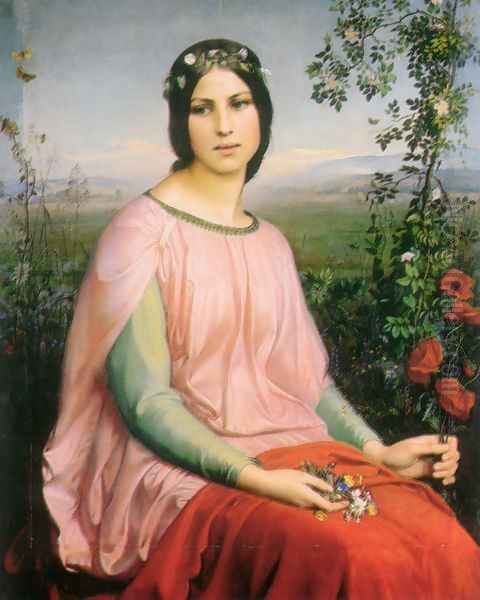
Despite the mixed reception, Janmot remained committed to his vision, tirelessly working on the cycle. Today, Le Poème de l’âme is housed primarily in the Musée des Beaux-Arts de Lyon and is recognized as a precursor to Symbolist art, anticipating the introspective and dreamlike qualities found in the works of later artists such as Odilon Redon, Gustave Moreau, and Pierre Puvis de Chavannes. Puvis de Chavannes, in particular, shared Janmot's interest in large-scale decorative cycles with allegorical themes and a muted, harmonious palette.
Key Themes and Stylistic Characteristics
Janmot's art is characterized by several recurring themes and distinct stylistic traits. His profound Catholic faith is the most dominant theme, informing nearly all his major works. He explored biblical narratives, lives of saints, and allegorical representations of spiritual concepts. Unlike some religious art of the period that could be overly sentimental or dogmatic, Janmot's approach was often deeply personal and imbued with a quiet sincerity.
His style is marked by a strong emphasis on line and clarity of form, a legacy of his training under Ingres and his admiration for early Renaissance masters. His figures are often elongated and graceful, rendered with a meticulous attention to detail. His color palette tends to be subtle and harmonious, often employing soft blues, pinks, and greens, particularly in the earlier, more idyllic parts of Le Poème de l’âme. There is a certain archaizing quality to his work, a deliberate turning away from the more painterly or naturalistic trends of his time towards a style that he felt better conveyed spiritual purity.
This stylistic choice connects him to the ideals of the Pre-Raphaelite Brotherhood in England, artists like Dante Gabriel Rossetti, John Everett Millais, and William Holman Hunt, who similarly sought inspiration in art before Raphael, valuing truth to nature, detailed symbolism, and serious subject matter. Though working independently, Janmot shared their dissatisfaction with prevailing academic conventions and their desire for a more spiritually authentic art.
His work often carries a strong narrative and didactic element, particularly in Le Poème de l’âme. He was not merely creating beautiful images but seeking to convey complex philosophical and theological ideas. This intellectual ambition, combined with his poetic sensibility, gives his art a unique depth. He was also a capable portraitist, producing sensitive and insightful likenesses of his friends and patrons.
Other Notable Works
Beyond Le Poème de l’âme, Janmot produced a significant body of work, including religious paintings, portraits, and decorative schemes.
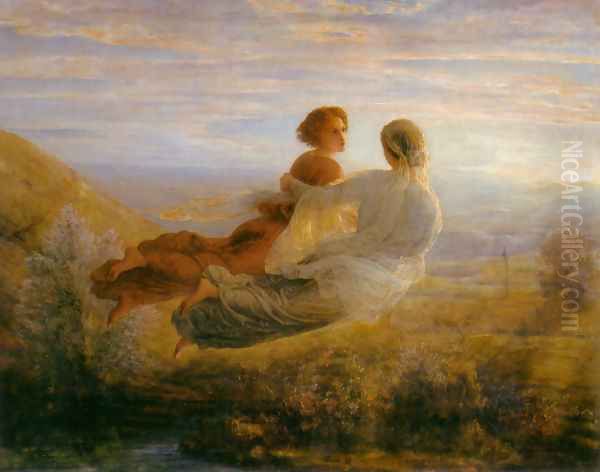
One of his early successes was The Resurrection of the Son of the Widow of Nain (1839, though sometimes mistakenly titled based on the provided text as Nazareth), which demonstrated his ability to handle large-scale religious compositions with both technical skill and emotional resonance.
Christ in the Garden of Gethsemane (1840) is another powerful religious work, showcasing his capacity for conveying pathos and spiritual struggle.
Fleur des Champs (Flower of the Fields, 1845) is a charming and tender painting, depicting a young woman in a landscape, embodying a sense of natural innocence and purity that aligns with the themes of his larger cycle. It captures a Romantic appreciation for nature intertwined with an idealized vision of femininity.
His portraiture, such as the likeness of his friend and fellow Lyonnais artist Louis Lamothe (another pupil of Ingres), or that of Lacordaire, the famous Dominican preacher, reveals his skill in capturing the character and intellect of his sitters. These portraits are marked by their clarity and psychological insight.
Janmot also undertook decorative commissions, including murals for churches. For instance, he worked on decorations for the Church of Saint-Polycarpe in Lyon and was commissioned for a mural in the Church of Saint-Augustin in Paris, though this latter project was unfortunately never fully realized due to various setbacks. These commissions allowed him to work on a grand scale, integrating his art within an architectural and devotional context, much like the Renaissance masters he admired.
A work like Nightmare (Cauchemar, 1849-1850) shows a different facet of his imagination, exploring darker, more unsettling themes that foreshadow the more troubled sections of Le Poème de l’âme and connect with the Romantic fascination for the sublime and the grotesque, as seen in works by artists like Henry Fuseli or Théodore Géricault.
Relationships with Contemporaries and Artistic Circles
Janmot was not an isolated figure, though his artistic path was highly individual. In Lyon, he was part of a circle of artists and intellectuals who shared his religious and philosophical concerns. Figures like Victor Orsel, Hippolyte Flandrin (another distinguished pupil of Ingres from Lyon), and the aforementioned Frédéric Ozanam were important interlocutors.
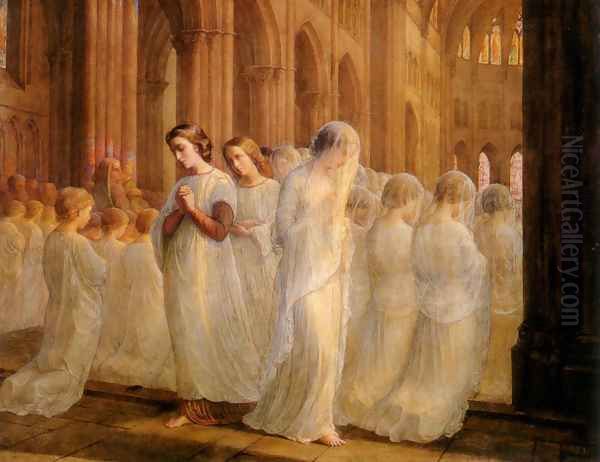
In Paris, his association with Ingres connected him to a significant artistic lineage. While he maintained respect for his master, his evolving style placed him somewhat apart from the stricter Neoclassicists. His work did attract the attention of discerning critics like Charles Baudelaire and Théophile Gautier. Baudelaire, in his Salon reviews, noted Janmot's talent for conveying "childlike grace" and his "charming and singular" qualities, even if he later expressed reservations about the systematic nature of Le Poème de l’âme.
Later in his career, Janmot's work found appreciation among a younger generation of Symbolist artists. Odilon Redon, known for his mysterious and dreamlike noirs, admired Janmot. Maurice Denis, a key theorist and painter of the Nabi group (who themselves drew inspiration from Gauguin and early Italian art), also recognized Janmot's significance as a precursor to their own spiritual and aesthetic concerns. This posthumous recognition by artists who were shaping the future of modern art underscores Janmot's quiet but persistent influence.
He also maintained correspondence with figures like the Comte de Montalembert, a prominent Catholic layman and politician, indicating his engagement with the broader intellectual and religious currents of his time. His friendship with the composer Charles Gounod is also noteworthy, suggesting shared artistic sympathies.
Challenges, Later Years, and Legacy
Janmot's career was not without its difficulties. The lukewarm reception of Le Poème de l’âme at the 1855 Universal Exhibition was a significant disappointment. Financial struggles also plagued him at various points in his life. A commission for a large mural, The Last Supper, for the refectory of the Dominicans in Lyon, was another significant undertaking, though its fate and current state are less clear.
He divided his time between Lyon and Paris, and later in life, spent time in Toulon. Despite setbacks, he continued to paint and write, remaining true to his artistic and spiritual convictions. His personal life also saw its share of sorrow, including the death of his first wife, Léonie de Saint-Paulet, in 1873. He later remarried.
Anne-François-Louis Janmot passed away on June 1, 1892, in Lyon (some sources may indicate Toulon, but Lyon is more consistently cited for his death). At the time of his death, his work was known primarily within a select circle. However, the late 19th and early 20th centuries saw a renewed interest in artists who had explored spiritual and subjective themes, leading to a gradual rediscovery of Janmot.
His legacy lies in his unique synthesis of classical form, Romantic sensibility, and profound spiritual introspection. He stands as an important link between the Lyon School, the tradition of Ingres, and the emerging Symbolist movement. Le Poème de l’âme remains his most enduring achievement, a deeply personal and ambitious exploration of the human condition through a spiritual lens. Artists like Georges Rouault, with his own intense religious imagery, or even Marc Chagall, with his poetic and dreamlike narratives, can be seen as distant inheritors of the kind of visionary art that Janmot pursued.
Today, Janmot is recognized as an artist of considerable talent and originality, whose work offers a poignant and beautiful counterpoint to the more dominant artistic trends of his era. His unwavering commitment to his personal vision, his technical mastery, and the spiritual depth of his art ensure his place as a significant, if sometimes overlooked, master of 19th-century French painting. His exploration of the soul's journey continues to resonate with those who seek an art that speaks to both the eye and the spirit.